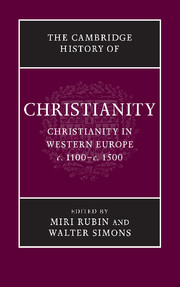Book contents
- Frontmatter
- Introduction
- PART I INSTITUTIONS AND CHANGE: 1100–1200
- PART II FORGING A CHRISTIAN WORLD, 1200–1300
- PART III THE ERECTION OF BOUNDARIES
- 10 Christians and Jews
- 11 Christendom and Islam
- 12 Christians and heretics
- 13 Women and men
- 14 Heaven, hell and purgatory: 1100–1500
- PART IV SHAPES OF A CHRISTIAN WORLD
- PART V CHRISTIAN LIFE IN MOVEMENT
- PART VI THE CHALLENGES TO A CHRISTIAN SOCIETY
- PART VII REFORM AND RENEWAL
- Select bibliography
- Index
- Map 1 Western Europe c. 1100 – c. 1500
- Map 2 Universities of Europe
- References
13 - Women and men
from PART III - THE ERECTION OF BOUNDARIES
Published online by Cambridge University Press: 28 March 2010
- Frontmatter
- Introduction
- PART I INSTITUTIONS AND CHANGE: 1100–1200
- PART II FORGING A CHRISTIAN WORLD, 1200–1300
- PART III THE ERECTION OF BOUNDARIES
- 10 Christians and Jews
- 11 Christendom and Islam
- 12 Christians and heretics
- 13 Women and men
- 14 Heaven, hell and purgatory: 1100–1500
- PART IV SHAPES OF A CHRISTIAN WORLD
- PART V CHRISTIAN LIFE IN MOVEMENT
- PART VI THE CHALLENGES TO A CHRISTIAN SOCIETY
- PART VII REFORM AND RENEWAL
- Select bibliography
- Index
- Map 1 Western Europe c. 1100 – c. 1500
- Map 2 Universities of Europe
- References
Summary
‘There is neither Jew nor Greek, there is neither slave nor free, there is neither male nor female; for you are all one in Christ Jesus’ (Gal. 3.28). This promise of equality between women and men, spelled out in an early Christian baptismal formula, and then repeated by Paul in his letter to the Galatians, awoke few echoes in the later Middle Ages. While medieval exegetes sometimes discussed the whole formula, the specific claim that there is ‘neither male nor female’ received very little attention. In contrast, notions of gender difference and gender hierarchy pervaded mainstream Christianity in the years between 1000 and 1500. In biblical commentaries and pastoral letters, in canon law and scholastic summae, the later medieval clergy repeated patristic and early medieval ideas about the distinct natures of women and men, and about the unequal relationship between the sexes, occasionally refining old arguments and addressing new issues as they arose. In homilies and admonitions, preachers retailed many of the same ideas to a broader audience of layfolk. And clergy and laity together performed gender difference and gender hierarchy within the ordinary rituals of parish life.
Keywords
- Type
- Chapter
- Information
- The Cambridge History of Christianity , pp. 187 - 199Publisher: Cambridge University PressPrint publication year: 2009
References
- 1
- Cited by



